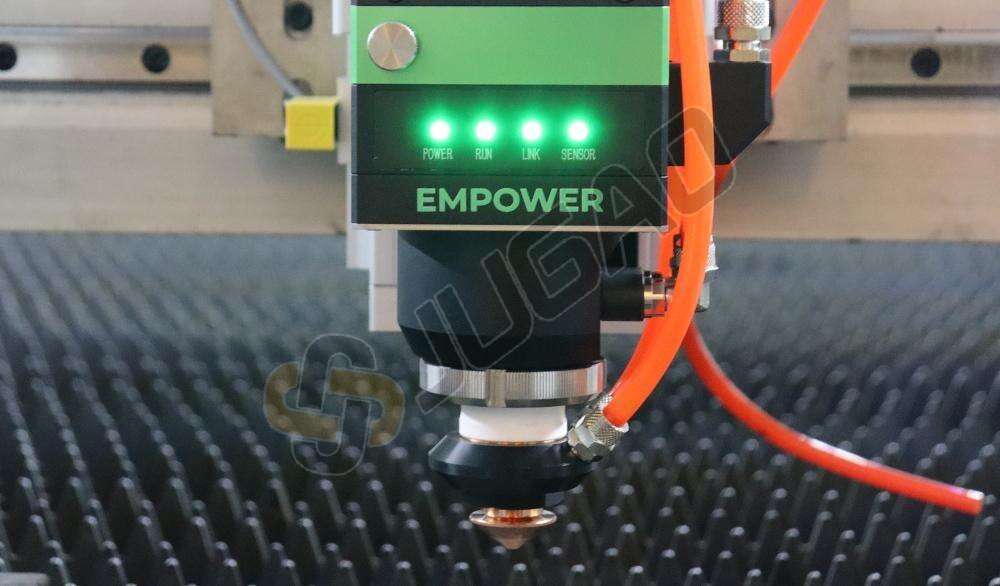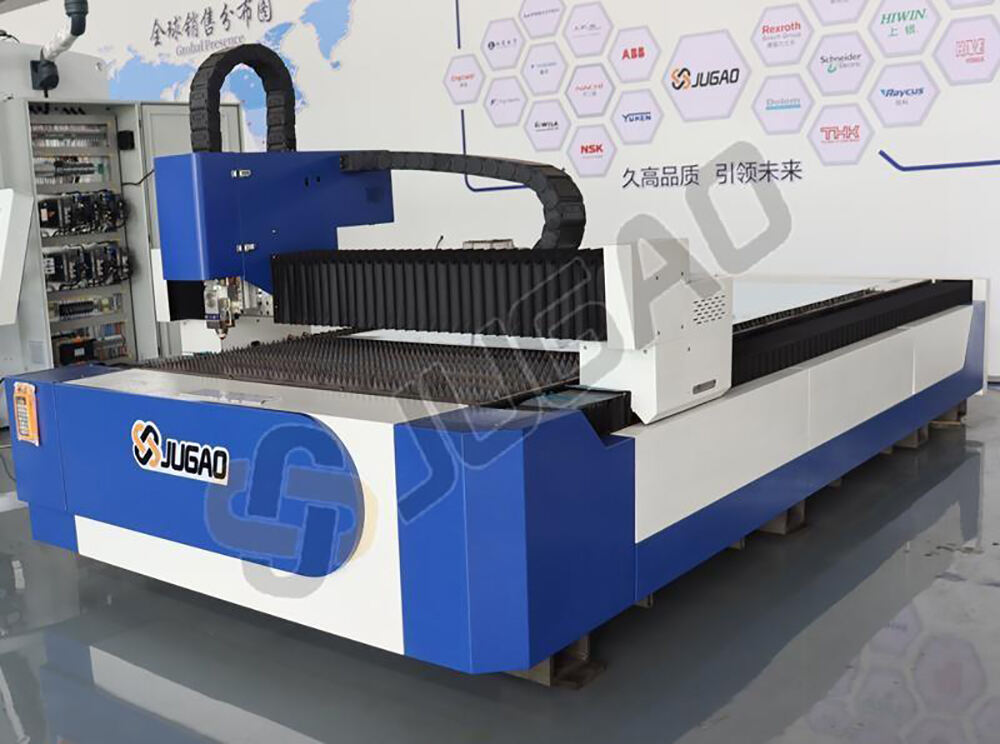Fiber Laser Cutting Machine Operation Guide
A fiber laser cutting machine uses a fiber laser as its light source, utilizing a laser beam to perform high-precision cutting of materials. When using a fiber laser cutting machine, you must follow these steps to ensure safe and efficient operation. The following is a user guide for fiber laser cutting machines.

1. How to Use a Fiber Laser Cutting Machine?
1) Preparing Before You Begin
– Safety Check
Wear protective equipment: Wear safety glasses, protective gloves, and work clothes.
– Equipment
Power Supply Check: Ensure the machine is connected to a stable power source.
Cooling System: Check for sufficient coolant and proper operation of the cooling system.
Gas Source: Verify that the auxiliary gas (such as oxygen or nitrogen) is sufficient and at the required pressure.
Ensure that the fiber optic cable is not damaged or excessively bent. Verify that all fasteners and connectors are secure.
– Environmental Preparation
Keep the work area free of flammable materials.
Equip yourself with necessary safety equipment, such as safety glasses and a fire extinguisher.
– Material Preparation
Select the appropriate material for your cutting requirements and clean the surface.
Secure the material onto the workbench, ensuring it is flat and secure.
2) Start the Fiber Laser Cutting Machine
Turn on the main power: Turn on the machine's main power switch.
Start the control system: Open the cutting machine's control panel and wait for the system to initialize.
Start the cooling system: Start the cooling system to ensure proper laser temperature control.
3) Set the cutting parameters
– Importing the cutting file:
Import the design file (such as DXF or other CAD format) into the control software.
Check that the cutting path is correct to avoid overlap or incorrect paths.
– Adjusting the process parameters
Selecting the cutting mode:
Select the appropriate cutting mode (e.g., carbon steel, stainless steel, aluminum alloy, etc.) based on the material type and thickness.
Laser power:
Select the appropriate power based on the material type and thickness.
Cutting speed:
Adjust the speed for optimal cutting quality.
Assist gas:
Nitrogen: Used for materials such as stainless steel and aluminum, resulting in smoother cut edges.
Oxygen: Used for carbon steel, improving cutting efficiency.
Air: Suitable for cost-effective cutting.
Focus position:
Adjust the focus based on the material thickness to ensure laser energy concentration.
4) Trial Cutting and Cutting
– Test Cutting
Perform a test cut on the corner of the material and observe the cutting results.
Adjust parameters such as power, speed, and focus position based on the test cut results.
– Final Cutting
After confirming that all settings are correct, start the cutting process.
Monitor the cutting status during the cutting process and note any abnormalities (such as abnormal sparks, incomplete cuts, etc.).
5) Post-Processing
– Check the Cutting Quality
The edges are smooth and burr-free.
The cut dimensions meet the design requirements.
Cleaning the Workbench: Remove any residue and waste, and keep the equipment clean.
– Shutting Down the Equipment:
Turn off the laser, cooling system, and control system.
Disconnect the main power supply.
6) Maintenance and Care
Daily Inspection: Clean the optical lens and inspect components such as optical fibers and cables.
Periodic Maintenance: Replace the coolant, clean the laser, and inspect the air lines.
Logbook: Record equipment usage and maintenance.
7) Other Precautions
u Safety precautions: Avoid looking directly into the laser beam during laser cutting; keep non-operating personnel away from the equipment.
u Environmental requirements: Maintain a dry and dust-free working environment.
u Emergency procedures: If any abnormality is detected, immediately press the emergency stop button, shut down the equipment, and troubleshoot.
Fiber laser cutting machines are high-precision tools used to cut a variety of materials, including metals, plastics, and composites. Following this guide will ensure safe and efficient operation of your fiber laser cutting machine, while maintaining optimal performance and longevity.
2. Fiber Laser Cutting Machine Operating Precautions
When using a fiber laser cutting machine, pay special attention to the following precautions to ensure safe and efficient operation.

1) Safety Protection
Wearing Protective Glasses:
When operating a laser cutting machine, laser protective glasses must be worn to protect your eyes from the laser beam. This should be worn even when the laser cutting machine is in standby or on.
Avoid Staring Directly into the Laser Beam:
During the cutting process, the laser beam is extremely hot, and direct exposure to the laser beam can cause serious injury. Never look directly into the cutting head, especially during cutting.
Work Area Protection:
Ensure that the laser cutting machine is surrounded by appropriate safety fences to prevent non-operating personnel from approaching the laser working area. Most equipment has safety guards, such as laser shielding glass or a protective cover.
2) Environmental Requirements
Good Ventilation:
The laser cutting process generates a certain amount of exhaust gas, smoke, and dust. Therefore, ensure that the work area has a good ventilation system or fume exhaust system to prevent the accumulation of harmful gases.
Temperature Control:
Maintain a moderate operating temperature for the laser cutting machine. Avoid excessively high or low temperatures that may affect the normal operation of the laser and cooling system. Humidity Control:
Excessive humidity can damage electrical equipment, while low humidity can cause static interference. Therefore, maintain appropriate humidity levels.
3) Equipment Maintenance
Regularly Check the Laser:
The laser is the core component of the fiber laser cutting machine. Regularly check the laser's condition to ensure that the fiber connection is intact and free of damage or stains. Fiber damage may cause laser beam instability or malfunction.
Cleaning the Optical Lens and Protective Mirror:
During the laser cutting process, smoke, dust, and impurities can easily accumulate on the optical lens and protective mirror, affecting laser quality. Clean the lens regularly to ensure stable laser beam transmission and cutting accuracy.
Checking the Cooling System:
The proper operation of the fiber laser cutting machine's cooling system is crucial. Regularly check the coolant level to ensure there are no leaks in the cooling system and to keep the laser temperature within the normal range.
Checking the Gas Supply System:
Ensure that there is an adequate supply of auxiliary gases such as oxygen, nitrogen, and air, that there are no leaks in the piping, and that the gas pressure meets cutting requirements.
4) Operating Precautions
Material Preparation:
Before cutting, ensure the material surface is clean and flat. Remove any debris such as oil, iron filings, and rust to prevent any degradation in cutting quality.
Focus Adjustment:
Ensure the laser focus is accurately adjusted to the material surface. Improper focus positioning can result in poor or incomplete cutting. Most fiber laser cutting machines are equipped with autofocus, but manual adjustment may be required in some cases.
Avoid Reflective Materials:
Be especially careful when cutting highly reflective materials (such as aluminum and copper). High reflectivity can cause the laser beam to reflect, potentially damaging the equipment or affecting cutting quality. When cutting such materials, select the appropriate assist gas and adjust the laser power and cutting speed as needed.
5) Monitoring the Cutting Process
Monitoring the Cutting Process:
During the cutting process, monitor the cutting quality, including whether the cut edge is smooth and any abnormalities (such as excessive sparks or uneven cutting). If any abnormalities are detected, stop cutting immediately and inspect the equipment.
Temperature Monitoring:
During laser cutting, the internal temperature of the equipment may rise, especially that of the laser and cooling system. Maintain the temperature within the normal range to prevent overheating and damage to the equipment.
Equipment Alarm System:
Many fiber laser cutting machines are equipped with an alarm system that sounds an alarm when the equipment experiences an abnormality. If a malfunction occurs, the machine should be stopped immediately and the cause should be investigated.
6) Operator Requirements
Professional Training:
Before operating a fiber laser cutting machine, operators should receive professional training and be familiar with the basics of fiber laser cutting machine operation, maintenance, and troubleshooting.
No Access for Non-Operators:
During the laser cutting process, unauthorized personnel are prohibited from entering the operating area, especially the cutting area.
7) Emergency Stop
Emergency Stop Button:
If a malfunction or emergency occurs during equipment operation, immediately press the emergency stop button to prevent further damage or an accident.
Abnormal Handling:
If the machine experiences an abnormality during cutting (such as abnormal sparks, overheating, or laser malfunction), the machine should be stopped and inspected immediately. The fiber laser cutting machine can only be operated after the fault has been corrected.

3. Summary
Compared to traditional laser cutting machines, fiber laser cutting machines offer advantages such as faster cutting speeds, lower maintenance costs, and a more focused laser beam. They can produce finer patterns and are widely used in cutting metal materials, particularly in the industrial processing of stainless steel, carbon steel, aluminum alloys, and other metals.
Fiber laser cutting machines are high-precision equipment and require strict adherence to safety regulations and regular maintenance. Proper operating procedures, environmental control, and equipment maintenance ensure efficient operation and cutting quality, effectively extending the equipment's lifespan.
Follow the above steps to safely and efficiently operate a fiber laser cutting machine. For special requirements, please refer to the equipment manual or contact technical support.


















































